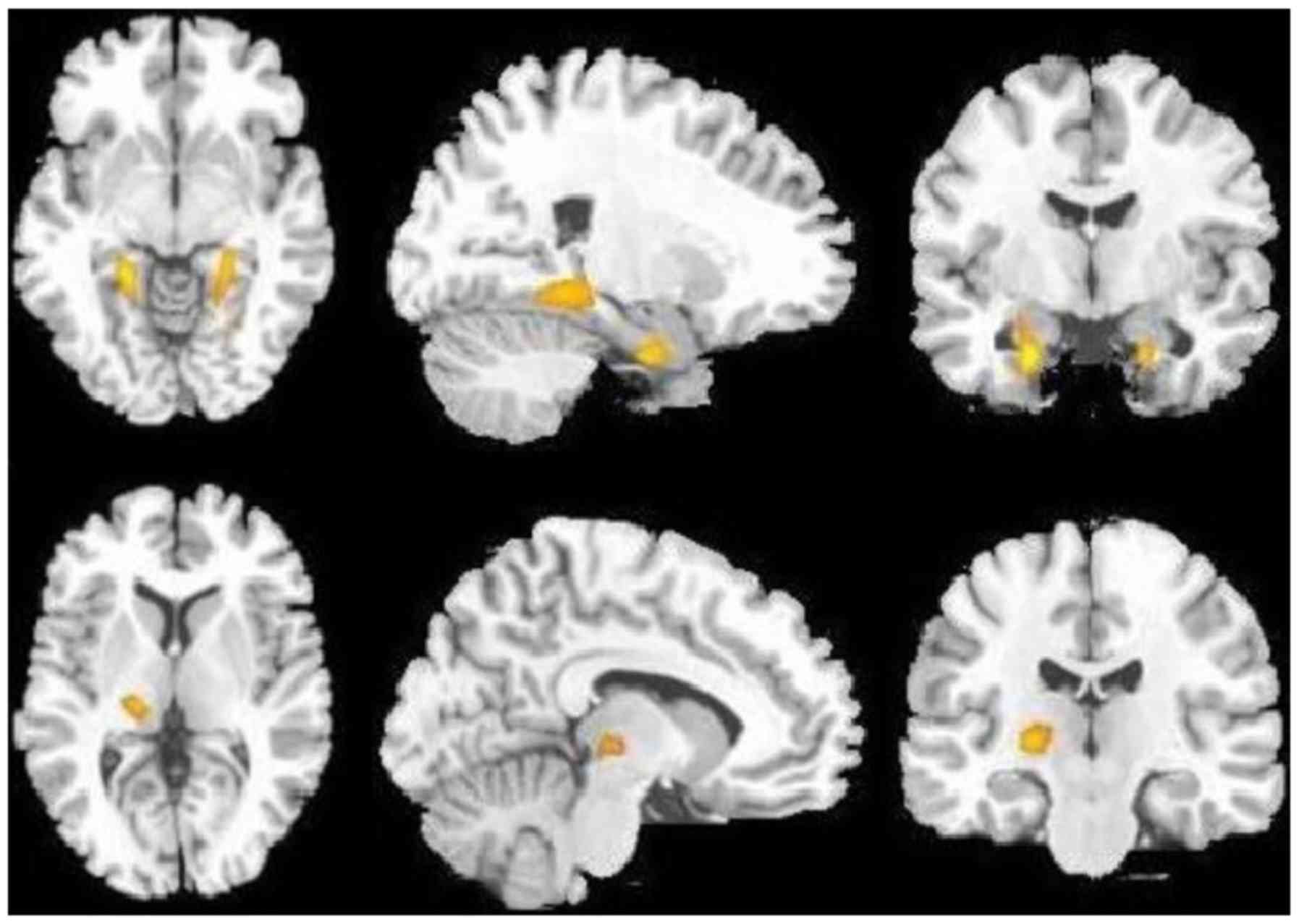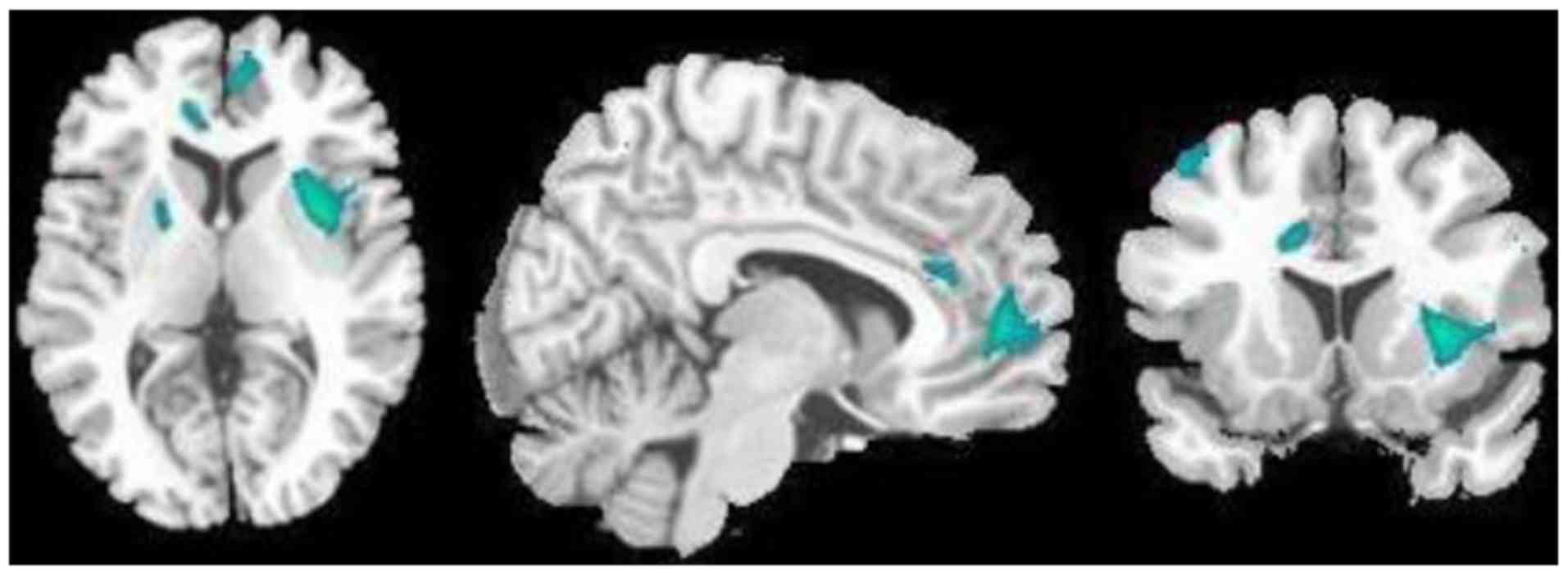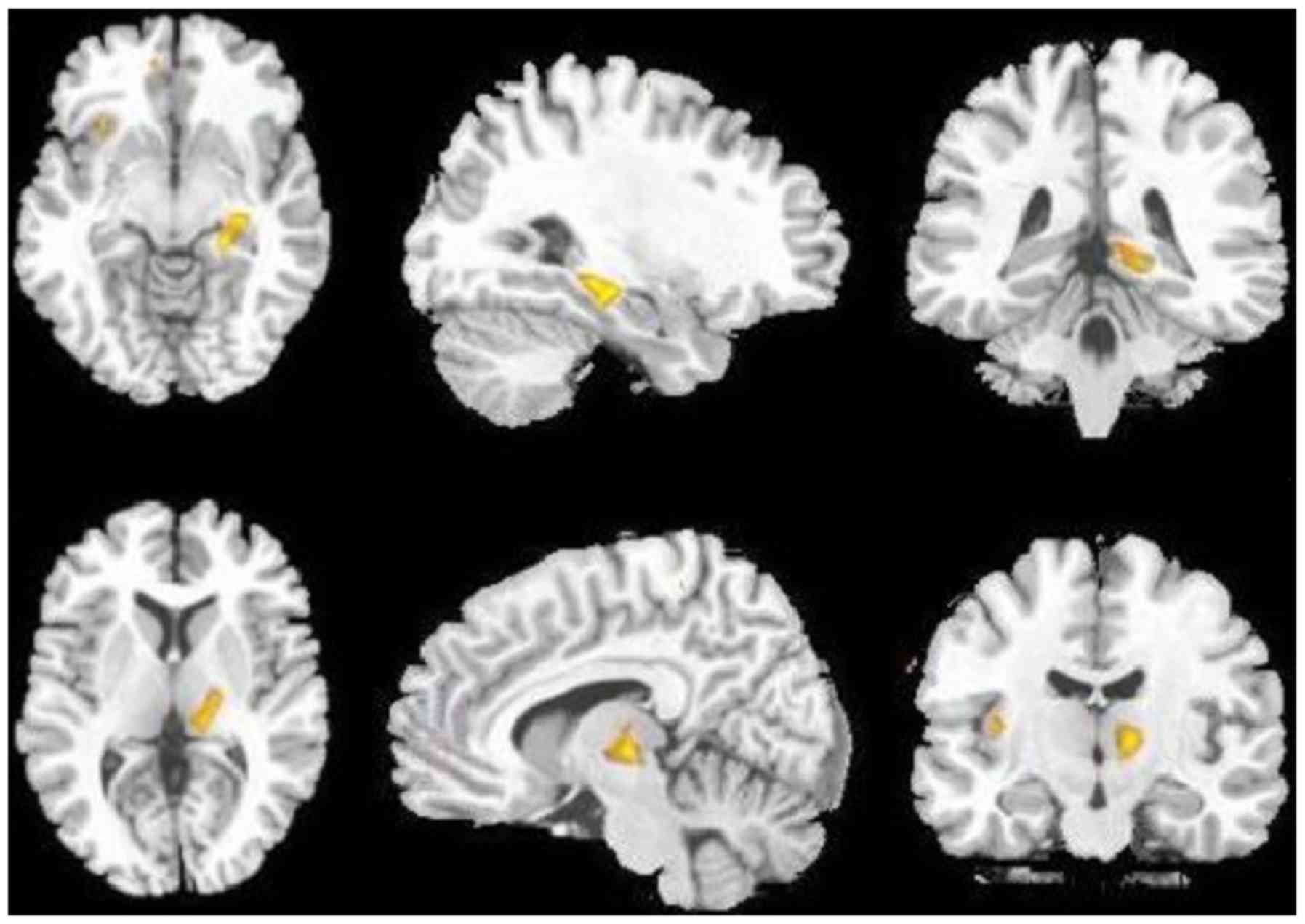|
1
|
Knutson B, Bhanji JP, Cooney RE, Atlas LY
and Gotlib IH: Neural responses to monetary incentives in major
depression. Biol Psychiatry. 63:686–692. 2008. View Article : Google Scholar : PubMed/NCBI
|
|
2
|
Maes M, Leonard BE, Myint AM, Kubera M and
Verkerk R: The new ‘5-HT’ hypothesis of depression: Cell-mediated
immune activation induces indoleamine 2, 3-dioxygenase, which leads
to lower plasma tryptophan and an increased synthesis of
detrimental tryptophan catabolites (TRYCATs), both of which
contribute to the onset of depression. Prog Neuropsychopharmacol
Biol Psychiatr. 35:702–721. 2011. View Article : Google Scholar
|
|
3
|
López-Figueroa AL, Norton CS,
López-Figueroa MO, Armellini-Dodel D, Burke S, Akil H, López JF and
Watson SJ: Serotonin 5-HT1A, 5-HT1B, and 5-HT2A receptor mRNA
expression in subjects with major depression, bipolar disorder, and
schizophrenia. Biol Psychiatry. 55:225–233. 2004. View Article : Google Scholar : PubMed/NCBI
|
|
4
|
Binder EB, Salyakina D, Lichtner P,
Wochnik GM, Ising M, Pütz B, Papiol S, Seaman S, Lucae S, Kohli M,
et al: Polymorphisms in FKBP5 are associated with increased
recurrence of depressive episodes and rapid response to
antidepressant treatment. Nat Genet. 36:13192004. View Article : Google Scholar : PubMed/NCBI
|
|
5
|
Lorenzetti V, Allen NB, Fornito A and
Yücel M: Structural brain abnormalities in major depressive
disorder: A selective review of recent MRI studies. J Affect
Disord. 117:1–17. 2009. View Article : Google Scholar : PubMed/NCBI
|
|
6
|
Lui S, Parkes LM, Huang X, Zou K, Chan RC,
Yang H, Zou L, Li D, Tang H, Zhang T, et al: Depressive disorders:
Focally altered cerebral perfusion measured with arterial
spin-labeling MR imaging. Radiology. 251:476–484. 2009. View Article : Google Scholar : PubMed/NCBI
|
|
7
|
Kim MJ, Hamilton JP and Gotlib LH: Reduced
caudate gray matter volume in women with major depressive disorder.
Psychiatry Res. 164:114–122. 2008. View Article : Google Scholar : PubMed/NCBI
|
|
8
|
Videbech P: PET measurements of brain
glucose metabolism and blood flow in major depressive disorder: A
critical review. Acta Psychiatr Scand. 101:11–20. 2000. View Article : Google Scholar : PubMed/NCBI
|
|
9
|
Mankoff DA, Shields AF and Krohn KA: PET
imaging of cellular proliferation. Radiol Clin North Am.
43:153–167. 2005. View Article : Google Scholar : PubMed/NCBI
|
|
10
|
Verger A, Roman S, Chaudat RM, Felician O,
Ceccaldi M, Didic M and Guedj E: Changes of metabolism and
functional connectivity in late-onset deafness: Evidence from
cerebral 18F-FDG-PET. Hear Res. 353:8–16. 2017.
View Article : Google Scholar : PubMed/NCBI
|
|
11
|
Staffaroni AM, Melrose RJ, Leskin LP,
Riskin-Jones H, Harwood D, Mandelkern M and Sultzer DL: The
functional neuroanatomy of verbal memory in Alzheimer's disease:
[18F]-Fluoro-2-deoxy-D-glucose positron emission
tomography (FDG-PET) correlates of recency and recognition memory.
J Clin Exp Neuropsychol. 39:682–693. 2017. View Article : Google Scholar : PubMed/NCBI
|
|
12
|
Ogawa S, Lee TM, Nayak AS and Glynn P:
Oxygenation-sensitive contrast in magnetic resonance image of
rodent brain at high magnetic fields. Magn Reson Med. 14:68–78.
1990. View Article : Google Scholar : PubMed/NCBI
|
|
13
|
Biswal B, Yetkin FZ, Haughton VM and Hyde
JS: Functional connectivity in the motor cortex of resting human
brain using echo-planar MRI. Magn Reson Med. 34:537–541. 1995.
View Article : Google Scholar : PubMed/NCBI
|
|
14
|
Damoiseaux JS, Rombouts SA, Barkhof F,
Scheltens P, Stam CJ, Smith SM and Beckmann CF: Consistent
resting-state networks across healthy subjects. Proc Natl Acad Sci
USA. 103:13848–13853. 2006. View Article : Google Scholar : PubMed/NCBI
|
|
15
|
Fox MD and Raichle ME: Spontaneous
fluctuations in brain activity observed with functional magnetic
resonance imaging. Nat Rev Neurosci. 8:700–711. 2007. View Article : Google Scholar : PubMed/NCBI
|
|
16
|
Zang Y, Jiang T, Lu Y, He Y and Tian L:
Regional homogeneity approach to fMRI data analysis. Neuroimage.
22:394–400. 2004. View Article : Google Scholar : PubMed/NCBI
|
|
17
|
Yu R, Chien YL, Wang HL, Liu CM, Liu CC,
Hsieh MH, Hwu HG and Tseng WY: Frequency-specific alternations in
the amplitude of low-frequency fluctuations in schizophrenia. Hum
Brain Mapp. 35:627–637. 2014. View Article : Google Scholar : PubMed/NCBI
|
|
18
|
de Kwaasteniet B, Ruhe E, Caan M, Rive M,
Olabarriaga S, Groefsema M, Heesink L, van Wingen G and Denys D:
Relation between structural and functional connectivity in major
depressive disorder. Biol Psychiatry. 74:40–47. 2013. View Article : Google Scholar : PubMed/NCBI
|
|
19
|
Liu Y, Wang K, Yu C, He Y, Zhou Y, Liang
M, Wang L and Jiang T: Regional homogeneity, functional
connectivity and imaging markers of Alzheimer's disease: A review
of resting-state fMRI studies. Neuropsychologia. 46:1648–1656.
2008. View Article : Google Scholar : PubMed/NCBI
|
|
20
|
Hoptman MJ, Zuo XN, Butler PD, Javitt DC,
D'Angelo D, Mauro CJ and Milham MP: Amplitude of low-frequency
oscillations in schizophrenia: A resting state fMRI study.
Schizophr Res. 117:13–20. 2010. View Article : Google Scholar : PubMed/NCBI
|
|
21
|
Towgood KJ, Pitkanen M, Kulasegaram R,
Fradera A, Soni S, Sibtain N, Reed LJ, Bradbeer C, Barker GJ, Dunn
JT, et al: Regional cerebral blood flow and FDG uptake in
asymptomatic HIV-1 men. Hum Brain Mapp. 34:2484–2493. 2013.
View Article : Google Scholar : PubMed/NCBI
|
|
22
|
Liu Z, Xu C, Xu Y, Wang Y, Zhao B, Lv Y,
Cao X, Zhang K and Du C: Decreased regional homogeneity in insula
and cerebellum: A resting-state fMRI study in patients with major
depression and subjects at high risk for major depression.
Psychiatry Res. 182:211–215. 2010. View Article : Google Scholar : PubMed/NCBI
|
|
23
|
Fitzgerald PB, Laird AR, Maller J and
Daskalakis ZJ: A meta-analytic study of changes in brain activation
in depression. Hum Brain Mapp. 29:683–695. 2008. View Article : Google Scholar : PubMed/NCBI
|
|
24
|
Guo WB, Sun XL, Liu L, Xu Q, Wu RR, Liu
ZN, Tan CL, Chen HF and Zhao JP: Disrupted regional homogeneity in
treatment-resistant depression: A resting-state fMRI study. Prog
Neuropsychopharmacol Biol Psychiatry. 35:1297–1302. 2011.
View Article : Google Scholar : PubMed/NCBI
|
|
25
|
Fujimoto T, Takeuchi K, Matsumoto T,
Fujita S, Honda K, Higashi Y and Kato N: Metabolic changes in the
brain of patients with late-onset major depression. Psychiatry Res.
164:48–57. 2008. View Article : Google Scholar : PubMed/NCBI
|
|
26
|
Lee HS, Choo IH, Lee DY, Kim JW, Seo EH,
Kim SG, Park SY, Shin JH, Kim KW and Woo JI: Frontal dysfunction
underlies depression in mild cognitive impairment: A FDG-PET study.
Psychiatry Investig. 7:208–214. 2010. View Article : Google Scholar : PubMed/NCBI
|
|
27
|
Hamilton JP, Etkin A, Furman DJ, Lemus MG,
Johnson RF and Gotlib IH: Functional neuroimaging of major
depressive disorder: A meta-analysis and new integration of base
line activation and neural response data. Am J Psychiatry.
169:693–703. 2012. View Article : Google Scholar : PubMed/NCBI
|
|
28
|
Chen S, Wu X, Lui S, Wu Q, Yao Z, Li Q,
Liang D, An D, Zhang X, Fang J, et al: Resting-state fMRI study of
treatment-naive temporal lobe epilepsy patients with depressive
symptoms. Neuroimage. 60:299–304. 2012. View Article : Google Scholar : PubMed/NCBI
|
|
29
|
Hamilton JP, Chen G, Thomason ME, Schwartz
ME and Gotlib IH: Investigating neural primacy in major depressive
disorder: Multivariate Granger causality analysis of resting-state
fMRI time-series data. Mol Psychiatry. 16:763–772. 2011. View Article : Google Scholar : PubMed/NCBI
|
|
30
|
Kendler KS and Gardner CO Jr: Boundaries
of major depression: An evaluation of DSM-IV criteria. Am J
Psychiatry. 155:172–177. 1998.PubMed/NCBI
|
|
31
|
Zimmerman M, Martinez JH, Young D,
Chelminski I and Dalrymple K: Severity classification on the
Hamilton depression rating scale. J Affect Disord. 150:384–388.
2013. View Article : Google Scholar : PubMed/NCBI
|
|
32
|
Kummer A, Cardoso F and Teixeira AL:
Generalized anxiety disorder and the Hamilton Anxiety Rating Scale
in Parkinson's disease. Arq Neuropsiquiatr. 68:495–501. 2010.
View Article : Google Scholar : PubMed/NCBI
|
|
33
|
Fox MD and Greicius M: Clinical
applications of resting state functional connectivity. Front Syst
Neurosci. 4:192010.PubMed/NCBI
|
|
34
|
Wu T, Long X, Zang Y, Wang L, Hallett M,
Li K and Chan P: Regional homogeneity changes in patients with
Parkinson's disease. Human brain mapping. 30:1502–1510. 2009.
View Article : Google Scholar : PubMed/NCBI
|
|
35
|
Yao Z, Wang L, Lu Q, Liu H and Teng G:
Regional homogeneity in depression and its relationship with
separate depressive symptom clusters: A resting-state fMRI study.
Journal of Affective Disorders. 115:430–438. 2009. View Article : Google Scholar : PubMed/NCBI
|
|
36
|
De Asis JM, Silbersweig DA, Pan H, Young
RC and Stern E: Neuroimaging studies of fronto-limbic dysfunction
in geriatric depression. Clin Neurosci Res. 2:324–330. 2003.
View Article : Google Scholar
|
|
37
|
Ketter TA, George MS, Kimbrell TA, Benson
BE and Post RM: Functional brain imaging, limbic function, and
affective disorders. Neuroscientist. 2:55–65. 1996. View Article : Google Scholar
|
|
38
|
Kennedy SH, Evans KR, Krüger S, Mayberg
HS, Meyer JH, McCann S, Arifuzzman AI, Houle S and Vaccarino FJ:
Changes in regional brain glucose metabolism measured with positron
emission tomography after paroxetine treatment of major depression.
Am J Psychiatry. 158:899–905. 2001. View Article : Google Scholar : PubMed/NCBI
|
|
39
|
Wu JC, Gillin JC, Buchsbaum MS, Schachat
C, Darnall LA, Keator DB, Fallon JH and Bunney WE: Sleep
deprivation PET correlations of Hamilton symptom improvement
ratings with changes in relative glucose metabolism in patients
with depression. J Affect Disord. 107:181–186. 2008. View Article : Google Scholar : PubMed/NCBI
|
|
40
|
Germain A, Nofzinger EA, Meltzer CC, Wood
A, Kupfer DJ, Moore RY and Buysse DJ: Diurnal variation in regional
brain glucose metabolism in depression. Biol Psychiatry.
62:438–445. 2007. View Article : Google Scholar : PubMed/NCBI
|
|
41
|
Mayberg HS, Brannan SK, Tekell JL, Silva
JA, Mahurin RK, McGinnis S and Jerabek PA: Regional metabolic
effects of fluoxetine in major depression: Serial changes and
relationship to clinical response. Biol Psychiatry. 48:830–843.
2000. View Article : Google Scholar : PubMed/NCBI
|
|
42
|
Kimbrell TA, Ketter TA, George MS, Little
JT, Benson BE, Willis MW, Herscovitch P and Post RM: Regional
cerebral glucose utilization in patients with a range of severities
of unipolar depression. Biol Psychiatry. 51:237–252. 2002.
View Article : Google Scholar : PubMed/NCBI
|
|
43
|
Drevets WC: Neuroimaging abnormalities in
the amygdala in mood disorders. Ann N Y Acad Sci. 985:420–444.
2003. View Article : Google Scholar : PubMed/NCBI
|
|
44
|
Abercrombie HC, Schaefer SM, Larson CL,
Oakes TR, Lindgren KA, Holden JE, Perlman SB, Turski PA, Krahn DD,
Benca RM and Davidson RJ: Metabolic rate in the right amygdala
predicts negative affect in depressed patients. Neuroreport.
9:3301–3307. 1998. View Article : Google Scholar : PubMed/NCBI
|
|
45
|
Weyts K, Vernooij M, Steketee R, Valkema R
and Smits M: Qualitative agreement and diagnostic performance of
arterial spin labelling MRI and FDG PET-CT in suspected early-stage
dementia: Comparison of arterial spin labelling MRI and FDG PET-CT
in suspected dementia. Clin Imaging. 45:1–7. 2017. View Article : Google Scholar : PubMed/NCBI
|
|
46
|
Kamm J, Ponto Boles LL, Manzel K,
Gaasedelen OJ, Nagahama Y, Abel T and Tranel D: Temporal lobe
asymmetry in FDG-PET uptake predicts neuropsychological and seizure
outcomes after temporal lobectomy. Epilepsy Behav. 78:62–67. 2018.
View Article : Google Scholar : PubMed/NCBI
|
|
47
|
Fu C: Regional homogeneity and FDG uptake
in patients with major depressive disorder. J Nucl Med.
58:12942017.
|













